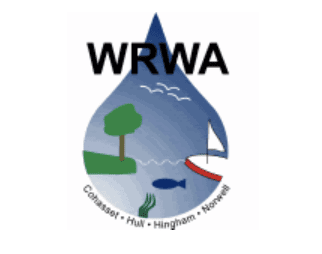June 22, 2021, Submitted by the Weir River Watershed Association
The South Shore. Coho. Gunrock. 02043. Red Sox Nation. Whether it’s your town, neighborhood, or even your favorite baseball team, there are a myriad of ways to define your home. Did you know that you also have a home watershed? Everyone does! A watershed is simply the name given to identify the land area in which all the fallen rain and snow drains (or “sheds”) into a common body of water. It includes underground water, called the aquifer, which contributes to streams and rivers. Here’s an illustration of a watershed.

For many residents of Hingham, Hull, Cohasset, Rockland, Weymouth, and Norwell, the Weir River Watershed is the one we call home. Comprising 23.4 square miles, the Weir River Watershed is a sub-basin of the Boston Harbor Watershed. Starting at Accord Pond, the Weir River Watershed supplies water to approximately 38,000 people in Hingham and Hull, and to parts of Cohasset. It provides a habitat for area wildlife. Additionally, it provides recreational opportunities for residents such as boating, swimming, and fishing. The watershed’s land is used for nature walks, hikes, biking, cross-country skiing, snow shoeing, birding, hunting, and shell fishing. In short, the watershed is a defining factor of why we love living here on the South Shore. Here’s a map of the Weir River Watershed.

Because watersheds support all of life within them, it’s important to be aware how our everyday choices impact the watershed’s vitality. A key measure of the health of the watershed is water flow, which you can check in real time on our website at www.weirriver.org. Traditionally, water use during summer months for lawn watering creates dangerously low waterflow levels in our watershed each year. In 2020, the Weir River actually ran dry from July to October. As this summer gets officially under way, we are already in a mild drought. Please consider not watering your lawn this year. You can get a yard sign to educate your neighbors about why you’re letting the grass go dormant at https://www.nsrwa.org/get-watersmart/sign-our-water-for-people-not-lawns-pledge/.
How we build on land also affects water levels. When land is paved or covered by impervious surfaces like buildings, precipitation is unable to soak into the ground and instead flows directly into the rivers and ocean. This decreases the amount of groundwater, resulting in less flow in the river. Along the way, the water runoff collects surface pollutants including salt, sand, and oil from roads and driveways, and pet waste and chemicals from our lawns, and deposits them straight into the rivers and ocean. Strategically placed rain gardens, such as the one planted outside the Hingham Public Library to capture roof runoff, channel this water back into the ground. To avoid damaging runoff, try to minimize unnecessary hardscape and your use of salt, chemicals, and fertilizers, and consider whether you could create a rain garden to encourage water absorption.
Every Weir River Watershed resident from Derby Street to the 02045 is responsible for maintaining the health of this fundamental resource. Find more information at the Weir River Watershed Association website. We are a volunteer, non-profit organization dedicated to promoting awareness and stewardship of the watershed. We provide educational programs to local schools, organize clean up events, and help monitor and report conditions on the river. You’re welcome to join as a member or as a participant at our next event as we work to keep our home watershed a welcoming place for generations to come.


